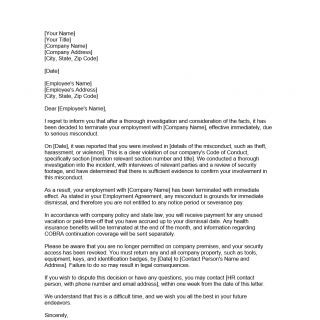Dismissal Letter
A dismissal letter is a formal document used by an employer to terminate an employee's employment due to serious misconduct. This letter serves as a written record of the termination and provides important information to both the employee and employer. Below are the components, important fields, and other factors to consider when composing a dismissal letter.
Components of a dismissal letter:
- Contact information: The letter should include the employer's name, address, and contact details, as well as the employee's name and address.
- Date: The date of issuing the letter, which is essential for keeping an accurate record.
- Subject line: A clear subject line indicating the purpose of the letter, such as "Notice of Termination" or "Dismissal Letter."
- Introduction: A brief introductory paragraph explaining the purpose of the letter.
- Reason for dismissal: A detailed explanation of the serious misconduct that led to the employee's dismissal. This should include dates, specific incidents, and any steps taken by the employer to address the problem (e.g., verbal/written warnings, suspension, etc.).
- Final pay and benefits: Information on any outstanding payments or benefits owed to the employee, such as severance pay, unused vacation days, and health insurance continuation.
- Company property: Instructions for returning any company-owned property, like keys, laptops, or other equipment.
- Appeal process (if applicable): Information on the employee's right to appeal the dismissal and the process for doing so.
- Legal consequences: A reminder of any legal consequences or ramifications of the misconduct, such as potential lawsuits or criminal charges.
- Signature: The letter should be signed by someone with the authority to terminate employment, such as a supervisor, manager, or HR representative.
Main fields to focus on are the reason for dismissal, final pay and benefits, and legal consequences. These sections are crucial for documenting the rationale behind the termination, ensuring the employee receives any owed compensation, and protecting the employer from potential legal disputes.
A dismissal letter is typically compiled when an employee engages in serious misconduct, such as theft, harassment, or violence. The parties involved in this document are the employer and the employee.
When compiling a dismissal letter, employers must ensure that the content is accurate, clear, and concise. Additionally, the letter must be compliant with the company's policies and adhere to labor laws in the region.
Dismissal Letter Sample
[Your Name]
[Your Title]
[Company Name]
[Company Address]
[City, State, Zip Code][Date]
[Employee's Name]
[Employee's Address]
[City, State, Zip Code]Dear [Employee's Name],
I regret to inform you that after a thorough investigation and consideration of the facts, it has been decided to terminate your employment with [Company Name], effective immediately, due to serious misconduct.
On [Date], it was reported that you were involved in [details of the misconduct, such as theft, harassment, or violence]. This is a clear violation of our company's Code of Conduct, specifically section [mention relevant section number and title]. We conducted a thorough investigation into the incident, with interviews of relevant parties and a review of security footage, and have determined that there is sufficient evidence to confirm your involvement in this misconduct.
As a result, your employment with [Company Name] has been terminated with immediate effect. As stated in your Employment Agreement, any misconduct is grounds for immediate dismissal, and therefore you are not entitled to any notice period or severance pay.
In accordance with company policy and state law, you will receive payment for any unused vacation or paid-time-off that you have accrued up to your dismissal date. Any health insurance benefits will be terminated at the end of the month, and information regarding COBRA continuation coverage will be sent separately.
Please be aware that you are no longer permitted on company premises, and your security access has been revoked. You must return any and all company property, such as tools, equipment, keys, and identification badges, by [Date] to [Contact Person's Name and Address]. Failure to do so may result in legal consequences.
If you wish to dispute this decision or have any questions, you may contact [HR contact person, with phone number and email address], within one week from the date of this letter.
We understand that this is a difficult time, and we wish you all the best in your future endeavors.
Sincerely,
[Your Name]
[Your Title]
The advantages of using a dismissal letter include providing a clear and formal record of the termination, protecting the employer from potential lawsuits, and ensuring that the employee understands their rights and responsibilities.
However, there can be problems with filling out a dismissal letter, such as inaccuracies, missing information, or a lack of documentation supporting the termination decision.
Alternative forms to a dismissal letter include a termination letter, which is used for reasons other than serious misconduct, such as poor performance or redundancy. The main difference between them is the severity of the reason for termination and the potential legal consequences associated with the misconduct.
Generally, the dismissal letter should be hand-delivered, sent via certified mail, or emailed to the employee. The employer should also keep a copy of the letter on file (either physically or electronically) as a record of the termination.
In summary, a dismissal letter is a formal document used to terminate employment due to severe misconduct, protecting both the employer and the employee. It contains essential information about the reason for termination, final pay and benefits, and any relevant legal matters. It is crucial for employers to create accurate, detailed, and compliant dismissal letters to avoid potential legal repercussions.

